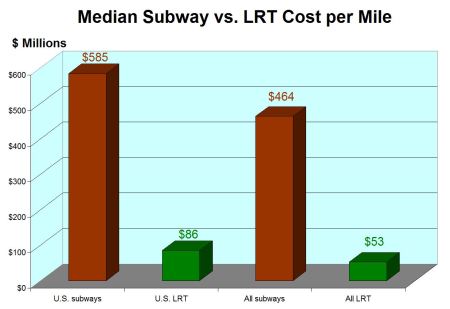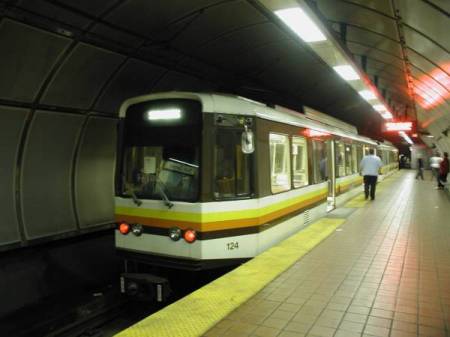
Subway cost per mile nearly 9 times higher than for light rail, says study
15 February 2014
Chart showing median cost results from Light Rail Now subway vs, LRT study. Graphic: Light Rail Now blog.
♦
For years, Austin’s civic leaders and official urban rail planners have been trying to figure out how to raise more than $500 million in local and federal funding for a new-start surface urban rail project — 5-6 miles of light rail transit (LRT) running in relatively lower-cost surface alignments. Suddenly, at least some official interest has turned to ….building a subway instead?
This seems to be influenced mainly by two factors:
• An aversion or reluctance to shift urban public thoroughfare space away from apparently precious motor vehicle traffic and re-allocate it to public transit (rail in this case), and
• Insistent claims by several subway proponents (disputed by professionals and advocates of LRT) that subway construction costs are nearly the same as, or only slightly more than, surface LRT.
Recent study results of subway-LRT investment costs posted on the Light Rail Now (LRN) blog site provide a sobering reality check on the cost issue. As portrayed graphically in the chart at the top of this post, LRN found median investment cost to be nearly 9 times higher for subway construction projects than for in-street LRT.
Projects examined were an assortment of “recent urban rail projects (all from the 2000s), either completed or well under construction and fully budgeted.” The report lists 24 subway and 13 LRT projects included in the analysis.
• Only “full subway projects (entirely or nearly totally underground)” were examined in the study, including subway portions of LRT projects.
• Only surface LRT projects exclusively, or nearly totally, in street alignments were included (“to compare the most difficult, highest-cost type of surface construction with subway construction”).
Summarizing the study results, LRN underscores the huge cost disparity between subway and in-street LRT construction, and the implications for a long-term rail expansion policy:
…for recent U.S. projects, subway construction has a median cost nearly seven times that of in-street LRT construction. Worldwide, the differential is nearly 9:1. And thats only comparing in-street LRT construction, not accounting for the possibility of, say, transitioning into an available railway alignment outside the city center, with far lower installation cost.
What this means is that, even if your community can somehow afford the initial financial commitment (even with federal assistance), expansion of your system will be severely attenuated. Basically, for a given amount of available funding, you can construct 7 to 9 times as much surface LRT as subway. Put another way: For available resources, you can have a far more comprehensive rail system with surface LRT, many times the size of a system relying on subway construction.

Buffalo’s 6.4-mile LRT line, with 5.2 miles (81%) in subway, has never been expanded since its opening in 1985. On the whole, the heavy cost of subway (and elevated) construction has been a powerful deterrent that has delayed or prevented the expansion of totally grade-separated urban rail systems. Photo: Buffalo Tourism.
(LRN’s results — which tabulate subway construction costs ranging from $114 million to well over $1 billion per mile — appear generally consistent with information provided at Project Connect’s Feb. 8th “interactive workshop”. Official consultants at this event described “tunnel” construction as costing in the range of $220 to $350 million per mile. However, it’s unclear whether this included the costs of underground stations, access portals and ramps, and major system costs such as rolling stock and storage-maintenance-operations facilities.)
Noting examples of appropriate subway deployment in Dallas and Portland, LRN emphasizes that, for these mature systems, some underground construction may be needed “to keep pace with ridership growth and the need for fast, more frequent service going beyond in-street capacity.” However, the article points out that “both cities relied primarily on surface construction to start and develop their initial systems….”
LRN’s report ends by cautioning that, in the face of evidence from this study, any commitment to launch a new urban rail startup system “should not be made on the supposition that a subway would cost ‘just a little bit more’ than constructing LRT in the street.”

I wonder, why didn’t they include a Premetro system, like the Green Line in Boston, the Muni Metro in San Francisco, or the trolleys in Philadelphia? A system that runs underground through Downtown/UT, running on the surface elsewhere, may be a pretty good solution for Austin.
Of course, most parts of Austin don’t quite have the same density as SF, Boston, or Philly. But one can hope.
[…] « / » https://austinrailnow.com/2014/02/15/subway-cost-per-mile-nearly-9-times-higher-than-for-light-rail-… […]